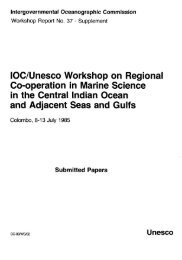Manual on sea level measurement and ... - unesdoc - Unesco
Manual on sea level measurement and ... - unesdoc - Unesco
Manual on sea level measurement and ... - unesdoc - Unesco
- No tags were found...
You also want an ePaper? Increase the reach of your titles
YUMPU automatically turns print PDFs into web optimized ePapers that Google loves.
Sea Level Measurement <strong>and</strong> Interpretati<strong>on</strong>The ESEAS-RI Sea Level Pilot Stati<strong>on</strong> in Vilagarcía de Arousa (Spain)B. Martín, B. Pérez, E. Alvarez FanjulPuertos del Estado, Madrid, Spain, E-mail: bego@puertos.esIntroducti<strong>on</strong>During the ESEAS-RI project (European Sea Level Service –Re<strong>sea</strong>rch Infrastructure), a test stati<strong>on</strong> for <strong>sea</strong> <strong>level</strong> sensorswas established at Vilagarcía de Arousa, <strong>on</strong> the northwestcoast of Spain. One of the objectives was to experimentwith different kinds of radar sensor, an emergingtechnology for measuring <strong>sea</strong> <strong>level</strong>, <strong>and</strong> compare theirperformance with other traditi<strong>on</strong>al <strong>and</strong> well proven tidegauges. The main advantage of radar appeared to be itsdem<strong>and</strong>ed accuracy, low maintenance <strong>and</strong> lack of influenceof air temperature, humidity or density of the water.The experiment was carried out when the existing networkswere requiring renewal, owing to the age of theequipment, <strong>and</strong> radar appeared as an even better opti<strong>on</strong>than acoustic sensors, <strong>and</strong> possible new applicati<strong>on</strong>s of<strong>sea</strong> <strong>level</strong> data had to be taken into account.Experiment <strong>and</strong> descripti<strong>on</strong> of the sensorsThe period of operati<strong>on</strong> of the different tide gauges isshown in Figure 2, <strong>and</strong> varies mainly due to the differentdates of incorporati<strong>on</strong> into the experiment <strong>and</strong> toproblems encountered during the first year, sometimeseven due to lack of experience with the equipment.Most of the equipment installed is very well known <strong>and</strong>described in the literature <strong>and</strong> in previous IOC manuals,such as the pressure (both the single pressure sensor<strong>and</strong> the bubbler sensor from POL) <strong>and</strong> the acousticgauges (both the Aquatrak from NOAA <strong>and</strong> the SRDfrom the REDMAR network). As was menti<strong>on</strong>ed, themain c<strong>on</strong>tributi<strong>on</strong> of the experiment was the testing ofseveral new radar sensors <strong>and</strong> the simultaneous installati<strong>on</strong>of so many tide gauges for the first time.Figure 1. Locati<strong>on</strong> of Vilagarcía de Arousa (left), photo of the test stati<strong>on</strong> (centre) <strong>and</strong> of the REDMAR stati<strong>on</strong> (right,an SRD acoustic sensor <strong>on</strong> another dock).The main modern technologies have been tested inVilagarcía: pressure, acoustic <strong>and</strong> radar, a total ofeight different sensors. Different instituti<strong>on</strong>s <strong>and</strong> privatecompanies provided sensors for the test; the Nati<strong>on</strong>alOceanographic <strong>and</strong> Atmospheric Administrati<strong>on</strong> (NOAA,USA) lent an Aquatrak acoustic sensor, <strong>and</strong> the ProudmanOceanographic Laboratory (POL, UK) lent a bubbler pressuresensor. Apart from this, two FMCW radar sensorswere provided by the companies Miros <strong>and</strong> ENRAF(Radac). The c<strong>on</strong>tributi<strong>on</strong> of Puertos del Estado was theacoustic sensor of the REDMAR network (SRD), <strong>and</strong> twopulse radar stati<strong>on</strong>s: Seba <strong>and</strong> Geónica. Finally, a SeaBirdpressure sensor was also installed during the experimentby the maintenance company SIDMAR Bernhard Pack.Focusing <strong>on</strong> the radar technology, two different typesof radar were installed (sensors were always located ata certain height above the <strong>sea</strong> surface):Pulse radar: operates <strong>on</strong> a similar principle to that ofthe acoustic sensor, by measuring the travel time ofmicrowave pulses between the sensor <strong>and</strong> the watersurface <strong>and</strong> the return echo to the sensor. The mainadvantage over the acoustic gauges is that the velocityof propagati<strong>on</strong> (light velocity, c, in air) of the wave doesnot depend <strong>on</strong> envir<strong>on</strong>mental c<strong>on</strong>diti<strong>on</strong>s, in particular<strong>on</strong> temperature gradients al<strong>on</strong>g the path of the pulse.This makes the installati<strong>on</strong> requirements less strict <strong>and</strong>no protective tube or pre-<strong>measurement</strong> calibrati<strong>on</strong> isneeded. Geónica <strong>and</strong> Seba radars are pulse radars <strong>and</strong>in fact use the same Vegapuls transducer.IOC <str<strong>on</strong>g>Manual</str<strong>on</strong>g>s <strong>and</strong> Guides No 14 vol IV61
















